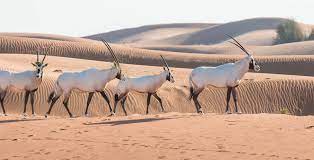With the advent of large numbers of zoos – with healthy collections of animals from around the world, the loss of a species in the wild can sometimes be reversed.

Unfortunately the history of the Oryx is not good. By 1800, its range had become severely restricted throughout the Arabian peninsular. Pressure merely increased after this. By 1948 Oryx had been hunted to near extinction, particularly after the advent of the motor car, allowed access to previously safeholds. In 1972, the last few Arabian Oryx were living in Oman, and were killed a few weeks later.
A mixture of overgrazing by livestocks, and capture for private collection were of lesser importance of this species extinction in the wild, but proved also to be its saving grace.
Today, there are thought to be about 1200 wild Arabian Oryx (1 of four Oryx species) living in Saudi Arabia, with a further 6-7000 living in the wild.
This means that this species has gone from being extinct in the wild, to merely vulnerable (as classed by the IUCN) the first to ever do this.
The process started in 1986 when 50 individuals were transferred to a research centre in Saudi Arabia. At this point only a few hundred survived in captivity. To add to the complication, many were found to be severely infected by TB. While in normal species any infected animal would be killed this could not be done. Instead they were treated with various drugs, any young born to infected females would be taken away and hand-reared, as TB can be transferred in the mothers milk.
In 1989 the first Arabian Oryx were rereleased into teh wild in central Saudi Arabia. A decision was made to enclose allof the reserve 2553 square km, about the area of Dorset, though this was good for the other wild life in the area, which included Arabian gazelles, red-necked ostrich and Houbara bustards.. This reserve now has over 500 of these Oryx making it the biggest wild population.
Later Oryx were released into a large reserve into the south of the country, and these have become established with a population of about 100. While small, this is the largest fully free ranging population int he world.
There is still much to be done. Currently, work is being done, to create cross border reserves with the UAE, Oman and Yemon -the other countries of the Arabian Peninsula. If this works, then the Oryx will become a full feature of the whole of the Arabian peninsula as it once was.











